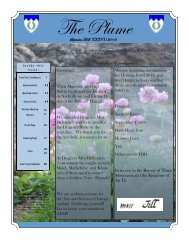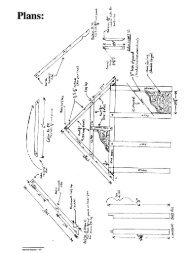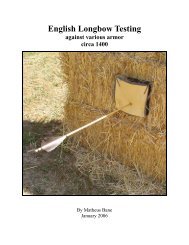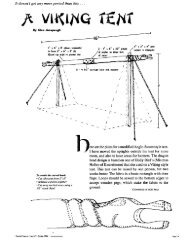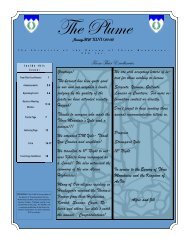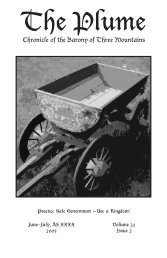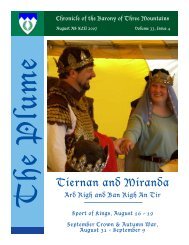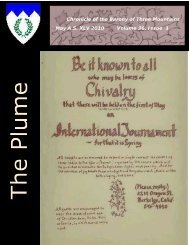The Kiev Psalter of 1397: An Analysis - CurrentMiddleAges.org
The Kiev Psalter of 1397: An Analysis - CurrentMiddleAges.org
The Kiev Psalter of 1397: An Analysis - CurrentMiddleAges.org
Create successful ePaper yourself
Turn your PDF publications into a flip-book with our unique Google optimized e-Paper software.
architectural perspective may be one <strong>of</strong> the elements <strong>of</strong> fourteenth-century Russian and<br />
Byzantine style which emerges in the eleventh-style ornamentation <strong>of</strong> the volume.<br />
<strong>An</strong>other particularly important iconographic element <strong>of</strong> the <strong>Kiev</strong> <strong>Psalter</strong> is the<br />
appearance <strong>of</strong> a Last Judgement scene on folio 180 recto. While the same scene does not<br />
appear in the Khludov <strong>Psalter</strong>, it is not an unknown image in Byzantine art. This<br />
particular Last Judgement is not in the complete iconographic form. At the top, Christ<br />
appears enthroned with six saints standing behind him. While the saints were at one time<br />
labeled, the inscriptions have unfortunately been cropped. Flanking Christ are Mary and<br />
John the Baptist, presenting the standard deësis form. <strong>The</strong> river <strong>of</strong> fire extends from the<br />
mouth <strong>of</strong> a beast at the base <strong>of</strong> Christ’s throne, passing through a group <strong>of</strong> six more saints<br />
seated below. <strong>The</strong> river continues past a group awaiting judgement, the psychostasis and<br />
finally opens into a pit <strong>of</strong> hell filling over half <strong>of</strong> the bottom margin. Hell is comprised <strong>of</strong><br />
a large demon labeled сатанас, or Satan, the head <strong>of</strong> an enormous beast with a gaping<br />
mouth, a set <strong>of</strong> black demons and a cluster <strong>of</strong> people, including monks and clergy.<br />
Appearing next to Ps. 122, the image must relate to line 5 (“For there are set thrones <strong>of</strong><br />
judgement, the thrones <strong>of</strong> the house <strong>of</strong> David”). Psalm 122 speaks <strong>of</strong> travelling to<br />
Jerusalem, so the potential interpretation suggested by the illustration is that the throne <strong>of</strong><br />
judgement on Judgement day will be situated at Jerusalem.<br />
<strong>The</strong> last ornamental aspect <strong>of</strong> the <strong>Kiev</strong> <strong>Psalter</strong> that bears discussion is the<br />
series <strong>of</strong> decorative initials. In the Khludov <strong>Psalter</strong>, the initials appear in rubrics in the<br />
margins. Typically, their x-height is over 1.5 times the size <strong>of</strong> the rest <strong>of</strong> the letters.<br />
<strong>The</strong>se initials appear to mark the beginning <strong>of</strong> every sentence. <strong>The</strong> <strong>The</strong>odore <strong>Psalter</strong> uses<br />
the same system, but also has some larger, more ornamental initials that probably mark<br />
the beginning <strong>of</strong> each psalm. <strong>The</strong>y likely use more than one colour, and their style<br />
appears to be vegetative. While the rubric letters are still 1.5 times the standard x-height,<br />
the ornamental initials are over 3 times the x-height <strong>of</strong> the rest <strong>of</strong> the text. <strong>The</strong>re does not<br />
appear to be any historiated initials. <strong>The</strong> <strong>Kiev</strong> <strong>Psalter</strong>, in turn uses the same elements<br />
seen in the <strong>The</strong>odore <strong>Psalter</strong>, however, the ornamental initials vary in size from 2 to 4<br />
times the x-height <strong>of</strong> the rest <strong>of</strong> the text. <strong>The</strong>y are typically vegetative in style, using red,<br />
blue, green and gold for colours. Occasionally, letter-forms using knot-work appear<br />
instead <strong>of</strong> the more traditional stylized leaf and floral motifs. While the latter seems to<br />
appear first in the eleventh century and persists through the fifteenth, the knot-work style<br />
13



